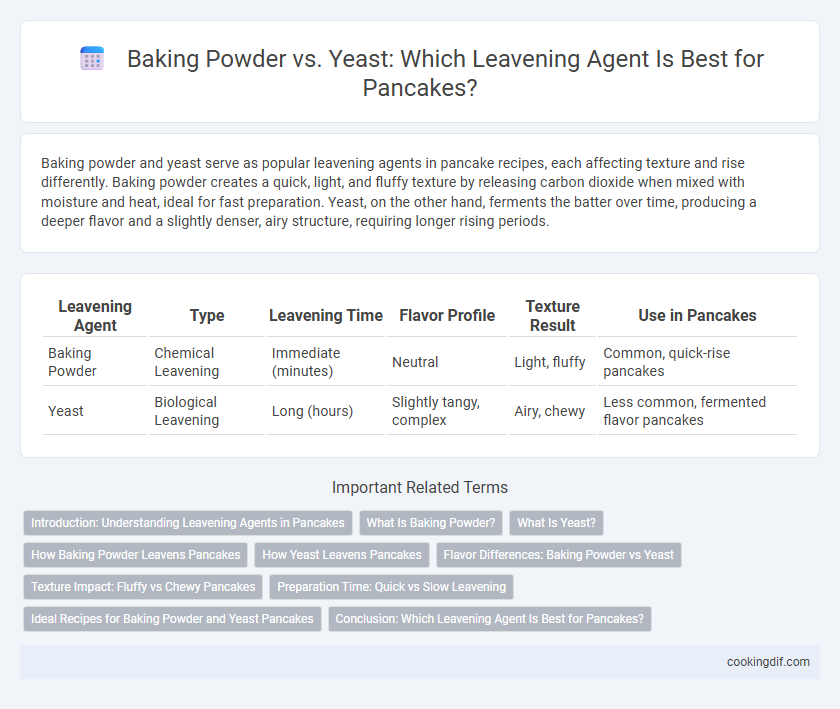Baking powder and yeast serve as popular leavening agents in pancake recipes, each affecting texture and rise differently. Baking powder creates a quick, light, and fluffy texture by releasing carbon dioxide when mixed with moisture and heat, ideal for fast preparation. Yeast, on the other hand, ferments the batter over time, producing a deeper flavor and a slightly denser, airy structure, requiring longer rising periods.
Table of Comparison
| Leavening Agent | Type | Leavening Time | Flavor Profile | Texture Result | Use in Pancakes |
|---|---|---|---|---|---|
| Baking Powder | Chemical Leavening | Immediate (minutes) | Neutral | Light, fluffy | Common, quick-rise pancakes |
| Yeast | Biological Leavening | Long (hours) | Slightly tangy, complex | Airy, chewy | Less common, fermented flavor pancakes |
Introduction: Understanding Leavening Agents in Pancakes
Baking powder and yeast serve as common leavening agents in pancakes, each producing distinct textures and flavors. Baking powder, a chemical leavening agent, releases carbon dioxide quickly when mixed with batter and heated, resulting in light and fluffy pancakes. Yeast, a biological leavening agent, ferments the batter over time, creating a tangy flavor and a more complex, airy crumb structure.
What Is Baking Powder?
Baking powder is a chemical leavening agent composed of an acid, a base, and a moisture absorber that produces carbon dioxide gas when mixed with liquid and heat, causing pancakes to rise and become fluffy. Unlike yeast, which relies on fermentation and requires longer proofing times, baking powder provides immediate leavening, making it ideal for quick pancake recipes. Its fast-acting properties ensure consistent texture and volume without the need for fermentation or extended rising periods.
What Is Yeast?
Yeast is a living microorganism used as a leavening agent in baking, responsible for fermenting sugars and producing carbon dioxide that causes dough to rise. Unlike baking powder, which is a chemical leavening agent producing gas through acid-base reactions, yeast requires time to ferment and develop flavor. This biological process not only leavens pancakes but also enhances texture and imparts a distinct, slightly tangy taste.
How Baking Powder Leavens Pancakes
Baking powder leavens pancakes by releasing carbon dioxide gas when mixed with wet ingredients and heated, creating air bubbles that cause the batter to rise and become fluffy. This chemical reaction occurs rapidly, allowing pancakes to cook evenly and develop a tender texture without the need for fermentation time required by yeast. Unlike yeast, baking powder provides a consistent rise and neutral flavor, ideal for quick and easy pancake preparation.
How Yeast Leavens Pancakes
Yeast leavens pancakes by fermenting sugars in the batter, producing carbon dioxide gas that forms bubbles and causes the batter to rise slowly. This natural fermentation process enhances the pancake's texture, creating a light, airy crumb with a slightly tangy flavor. Unlike baking powder, which reacts quickly, yeast requires longer resting time for optimal leavening and flavor development.
Flavor Differences: Baking Powder vs Yeast
Baking powder imparts a neutral, slightly metallic taste that allows the pancake's other flavors to shine, producing a light and fluffy texture with a quick rise. Yeast fermentation creates complex, tangy, and slightly sweet flavor notes due to organic acid and alcohol production, resulting in a chewier, bread-like pancake with a distinct aroma. Choosing between baking powder and yeast impacts both the flavor profile and texture, with baking powder offering simplicity and yeast enhancing depth and character.
Texture Impact: Fluffy vs Chewy Pancakes
Baking powder produces pancakes with a light, fluffy texture due to its fast-acting chemical reaction that creates air bubbles quickly during cooking. Yeast fermentation results in a denser, chewier pancake by developing gluten and allowing the batter to rise slowly over time. The choice between baking powder and yeast directly influences the pancake's softness and mouthfeel, with baking powder favored for soft fluffiness and yeast preferred for a heartier chewiness.
Preparation Time: Quick vs Slow Leavening
Baking powder acts as a fast-acting leavening agent, producing carbon dioxide immediately upon mixing with wet ingredients, which significantly reduces the preparation time for pancakes. Yeast requires a longer fermentation period to create bubbles, resulting in a slower rise and extended preparation time. Choosing baking powder enables quick pancake batter preparation, while yeast delivers a distinct texture and flavor through slow leavening.
Ideal Recipes for Baking Powder and Yeast Pancakes
Baking powder is ideal for pancakes requiring quick and consistent rise, producing light, fluffy textures in recipes like classic buttermilk pancakes or blueberry pancakes. Yeast pancakes benefit from longer fermentation, creating a slightly tangy flavor and airy crumb suited for recipes such as traditional Russian blini or Dutch baby pancakes. Choosing baking powder or yeast as the leavening agent significantly affects flavor, texture, and preparation time in pancake recipes.
Conclusion: Which Leavening Agent Is Best for Pancakes?
Baking powder is the preferred leavening agent for pancakes due to its ability to produce a consistent, light, and fluffy texture quickly without requiring fermentation time like yeast. Yeast, while providing a distinct flavor and airy crumb, demands longer rising periods unsuitable for fast pancake preparation. For optimal pancakes with minimal preparation time and reliable results, baking powder is the superior choice.
Baking powder vs yeast for leavening agent Infographic

 cookingdif.com
cookingdif.com